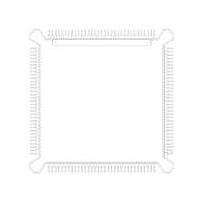MC68HC16Z1CEH16 Freescale Semiconductor, MC68HC16Z1CEH16 Datasheet - Page 213

MC68HC16Z1CEH16
Manufacturer Part Number
MC68HC16Z1CEH16
Description
IC MCU 16BIT 16MHZ 132-PQFP
Manufacturer
Freescale Semiconductor
Series
HC16r
Specifications of MC68HC16Z1CEH16
Core Processor
CPU16
Core Size
16-Bit
Speed
16MHz
Connectivity
EBI/EMI, SCI, SPI
Peripherals
POR, PWM, WDT
Number Of I /o
16
Program Memory Type
ROMless
Ram Size
1K x 8
Voltage - Supply (vcc/vdd)
2.7 V ~ 5.5 V
Data Converters
A/D 8x10b
Oscillator Type
Internal
Operating Temperature
-40°C ~ 85°C
Package / Case
132-QFP
Processor Series
HC16Z
Core
CPU16
Data Bus Width
16 bit
Controller Family/series
68HC16
No. Of I/o's
26
Ram Memory Size
1KB
Cpu Speed
16MHz
No. Of Timers
2
Embedded Interface Type
QSPI, SCI
Rohs Compliant
Yes
Package
132PQFP
Family Name
HC16
Maximum Speed
16 MHz
Operating Supply Voltage
3.3|5 V
Number Of Programmable I/os
16
On-chip Adc
8-chx10-bit
Number Of Timers
11
Data Ram Size
1 KB
Interface Type
SCI, SPI, UART
Maximum Clock Frequency
16 MHz
Maximum Operating Temperature
+ 85 C
Mounting Style
SMD/SMT
Minimum Operating Temperature
- 40 C
Lead Free Status / RoHS Status
Lead free / RoHS Compliant
Eeprom Size
-
Program Memory Size
-
Lead Free Status / Rohs Status
Lead free / RoHS Compliant
Available stocks
Company
Part Number
Manufacturer
Quantity
Price
Company:
Part Number:
MC68HC16Z1CEH16
Manufacturer:
Freescale Semiconductor
Quantity:
10 000
Part Number:
MC68HC16Z1CEH16
Manufacturer:
FREESCALE
Quantity:
20 000
- Current page: 213 of 500
- Download datasheet (6Mb)
9.2.1.2 Freeze Operation
9.2.1.3 QSM Interrupts
M68HC16 Z SERIES
USER’S MANUAL
The freeze FRZ[1:0] bits in QSMCR are used to determine what action is taken by the
QSM when the IMB FREEZE signal is asserted. FREEZE is asserted when the CPU16
enters background debug mode. At the present time, FRZ0 has no effect; setting
FRZ1 causes the QSPI to halt on the first transfer boundary following FREEZE asser-
tion. Refer to
ground debug mode.
Both the QSPI and SCI can generate interrupt requests. Each has a separate interrupt
request priority register. A single vector register is used to generate exception vector
numbers.
The values of the ILQSPI and ILSCI fields in QILR determine the priority of QSPI and
SCI interrupt requests. The values in these fields correspond to internal interrupt re-
quest signals IRQ[7:1]. A value of %111 causes IRQ7 to be asserted when a QSM in-
terrupt request is made. Lower field values cause correspondingly lower-numbered
interrupt request signals to be asserted. Setting the ILQSPI or ILSCI field values to
%000 disables interrupts for the QSPI and the SCI respectively. If ILQSPI and ILSCI
have the same non-zero value, and the QSPI and SCI make simultaneous interrupt
requests, the QSPI has priority.
When the CPU16 acknowledges an interrupt request, it places the value in the condi-
tion code register interrupt priority (IP) mask on ADDR[3:1]. The QSM compares the
IP mask value to the priority of the interrupt request to determine whether it should
contend for arbitration. QSM arbitration priority is determined by the value of the IARB
field in QSMCR. Each module that can generate interrupt requests must have a non-
zero IARB value, otherwise the CPU16 will identify any such interrupt requests as spu-
rious and take a spurious interrupt exception. Arbitration is performed by means of se-
rial contention between values stored in individual module IARB fields.
When the QSM wins interrupt arbitration, it responds to the CPU16 interrupt acknowl-
edge cycle by placing an interrupt vector number on the data bus. The vector number
is used to calculate displacement into the CPU16 exception vector table. SCI and
QSPI vector numbers are generated from the value in the QIVR INTV field. The values
of bits INTV[7:1] are the same for both the QSPI and the SCI. The value of INTV0 is
supplied by the QSM when an interrupt request is made. INTV0 = 0 for SCI interrupt
requests; INTV0 = 1 for QSPI interrupt requests.
At reset, INTV[7:0] is initialized to $0F, the uninitialized interrupt vector number. To en-
able interrupt-driven serial communication, a user-defined vector number must be writ-
ten to QIVR, and interrupt handler routines must be located at the addresses pointed
to by the corresponding vector. Writes to INTV0 have no effect. Reads of INTV0 return
a value of one.
Refer to
TEGRATION MODULE
SECTION 4 CENTRAL PROCESSOR UNIT
4.14.4 Background Debug Mode
Freescale Semiconductor, Inc.
For More Information On This Product,
for more information about exceptions and interrupts.
QUEUED SERIAL MODULE
Go to: www.freescale.com
for more information about back-
and
SECTION 5 SYSTEM IN-
9-3
Related parts for MC68HC16Z1CEH16
Image
Part Number
Description
Manufacturer
Datasheet
Request
R
Part Number:
Description:
Manufacturer:
Freescale Semiconductor, Inc
Datasheet:
Part Number:
Description:
Manufacturer:
Freescale Semiconductor, Inc
Datasheet:
Part Number:
Description:
Manufacturer:
Freescale Semiconductor, Inc
Datasheet:
Part Number:
Description:
Manufacturer:
Freescale Semiconductor, Inc
Datasheet:
Part Number:
Description:
Manufacturer:
Freescale Semiconductor, Inc
Datasheet:
Part Number:
Description:
Manufacturer:
Freescale Semiconductor, Inc
Datasheet:
Part Number:
Description:
Manufacturer:
Freescale Semiconductor, Inc
Datasheet:
Part Number:
Description:
Manufacturer:
Freescale Semiconductor, Inc
Datasheet:
Part Number:
Description:
Manufacturer:
Freescale Semiconductor, Inc
Datasheet:
Part Number:
Description:
Manufacturer:
Freescale Semiconductor, Inc
Datasheet:
Part Number:
Description:
Manufacturer:
Freescale Semiconductor, Inc
Datasheet:
Part Number:
Description:
Manufacturer:
Freescale Semiconductor, Inc
Datasheet:
Part Number:
Description:
Manufacturer:
Freescale Semiconductor, Inc
Datasheet:
Part Number:
Description:
Manufacturer:
Freescale Semiconductor, Inc
Datasheet:
Part Number:
Description:
Manufacturer:
Freescale Semiconductor, Inc
Datasheet:











